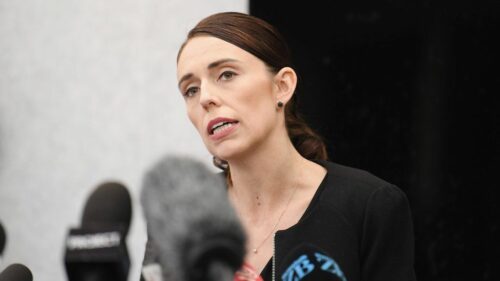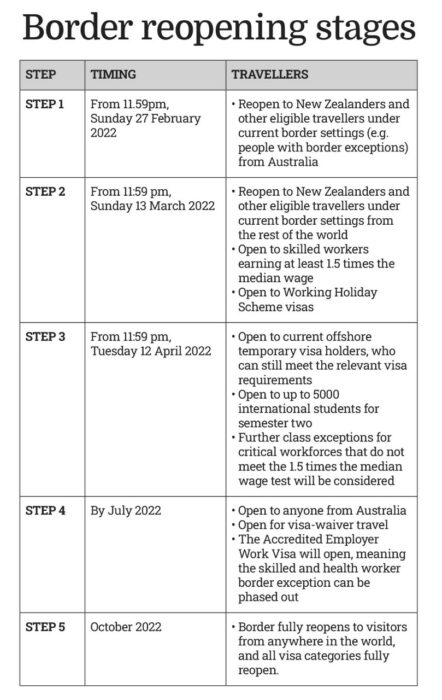
The border is to reopen to vaccinated Kiwis travelling from Australia on February 27.
And the border reopens to New Zealanders in the rest of the world a fortnight later – March 13.
Prime Minister Jacinda Ardern made the announcement in a speech in Auckland this morning.
She also confirmed MIQ is to be removed for most travellers in a phased reconnection and replaced by self-isolation and tests on-arrival. MIQ is to remain for the unvaccinated.
Ardern said it was time for New Zealand to move again.
“With our community better protected we must then turn to the importance of reconnection,” the PM said.
“Families and friends need to reunite. Our businesses need skills to grow. Exporters need to travel to make new connections.
“And so today in five steps, we move forward with our plan to reconnect New Zealand to the world.”
At step two at 11.59pm on Sunday March 13, there will also be an expanded border exception for critical workers, and skilled workers earning at least 1.5 times the median wage who will also be eligible to enter New Zealand, along with highly skilled workers’ family members who may have been separated from their loved ones.
This means that health workers, farm managers, horticultural workers, tech sector professionals, those working for accounting services, in education and construction, will all be eligible to enter New Zealand, self-isolate for a short period and then go about their business. The PM said this adds to the more than 17,000 critical workers who have already come to New Zealand since our borders closed.
“Our Working Holiday Schemes will also reopen in stages from step 2,” Ardern said.
Step 3 begins from 11:59pm Tuesday April 12. “Here we further extend our border extension to include a large international student cohort of up to 5000 students for entry ahead of semester 2 and temporary visa holders who still meet relevant visa requirements.”

The Government’s reconnecting plan will see all New Zealanders and key visa holders able to start to enter the country over the coming three months, assisting with the economic recovery and immediately address worker shortages, Covid-19 Response Minister Chris Hipkins said today.
“This is a very carefully developed plan that replaces MIQ for the vast majority of travellers while ensuring we maintain ongoing measures to reduce the spread of Covid-19 in our community from recent arrivals,” Hipkins said.
“With 94 per cent of our population fully vaccinated, and 92 per cent of those over 18 now eligible for a booster by the end of February, it’s time to shift gears in our Covid-19 response to focus on reconnection and recovery.
“By reducing the gap to get boosted to three months, we’re ensuring we reach our highest possible boosted rates before fully reopening.
“By the time we start to reopen our border, we’ll be one of the most vaccinated and most boosted countries in the world and the Covid-19 Protection Framework will be well established in helping to manage Covid outbreaks.”
Hipkins said the plan has built-in protections to help manage risks such as future variants. A phased approach to reopening reduces the risk of a surge of cases, while prioritising the return of New Zealanders and much-needed entry of skilled workers, he said.
“Having MIQ for every traveller was a temporary setting for when none of us had protection. New Zealanders need to reconnect with one another. Families and friends need to reunite. Our businesses need skills to grow. Exporters need to travel to make new connections,” said Hipkins.
Steps 1 and 2
From February 27, vaccinated New Zealanders and eligible travellers from Australia will be able to enter New Zealand without staying in MIQ and two weeks later from 13 March, New Zealanders and eligible travellers from the rest of the world will be able to come home.
“While travellers will no longer need to stay in MIQ, we are maintaining border measure to reduce the spread of the virus,” Hipkins said.
“The self-isolation requirements for travellers will mirror the way we treat contacts of cases in New Zealand. That means a current requirement of 10 days, but that will drop to 7 days when we move to phase two of our pandemic plan as cases rise.
“Isolation requirements will be kept under constant review, and we do expect them to reduce. The reopening to visa-free tourists is also likely to be brought forward, with July being the latest date we anticipate this happening.
“All arrivals will be provided three rapid antigen tests at the airport, one for use on day 0/1, and one for use on day 5/6, with one extra for backup. This approach means we will continue to identify cases that enter though the border and limit their wider contact with the community.
“In addition, we will continue to whole genome sequence all returnees who test positive to rapidly identify and respond to new variants.”
Steps 3 to 5
“This plan represents a significant step forward in addressing skills and labour shortages and accelerates our economic recovery,” Immigration Minister Kris Faafoi said today.
“Reopening of the border to a range of visa holders is a critical part in our plan to rebuild from Covid.
“From 13 March, just over five weeks away, we will start re-opening Working Holiday Visa schemes. This will supply urgently needed workers for the tourism, hospitality, wine and horticultural sectors as well as providing some much-needed visitor spending,” Faafoi said.
“Also from 13 March, we’re simplifying the application process for the critical worker border exception. Skilled workers with job offers paying at least 1.5 times, instead of double, the median wage will be able to come in without the need to demonstrate that their skills aren’t readily obtainable in New Zealand.
“Before Covid, New Zealand was issuing over one million visitor visas per year. What’s being announced today is about gearing up in manageable steps to fully re-open as safely as possible to enable us to live with Covid but not be overwhelmed by it.”









